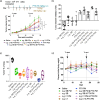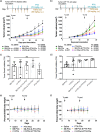Combination of polymeric micelle formulation of TGFβ receptor inhibitors and paclitaxel produces consistent response across different mouse models of Triple-negative breast cancer
- PMID: 39553439
- PMCID: PMC11561794
- DOI: 10.1002/btm2.10681
Combination of polymeric micelle formulation of TGFβ receptor inhibitors and paclitaxel produces consistent response across different mouse models of Triple-negative breast cancer
Abstract
Triple-negative breast cancer (TNBC) is notoriously difficult to treat due to the lack of targetable receptors and sometimes poor response to chemotherapy. The transforming growth factor beta (TGFβ) family of proteins and their receptors (TGFRs) are highly expressed in TNBC and implicated in chemotherapy-induced cancer stemness. Here, we evaluated combination treatments using experimental TGFR inhibitors (TGFβi), SB525334 (SB), and LY2109761 (LY) with paclitaxel (PTX) chemotherapy. These TGFβi target TGFR-I (SB) or both TGFR-I and TGFR-II (LY). Due to the poor water solubility of these drugs, we incorporated each of them in poly(2-oxazoline) (POx) high-capacity polymeric micelles (SB-POx and LY-POx). We assessed their anticancer effect as single agents and in combination with micellar PTX (PTX-POx) using multiple immunocompetent TNBC mouse models that mimic human subtypes (4T1, T11-Apobec and T11-UV). While either TGFβi or PTX showed a differential effect in each model as single agents, the combinations were consistently effective against all three models. Genetic profiling of the tumors revealed differences in the expression levels of genes associated with TGFβ, epithelial to mesenchymal transition (EMT), TLR-4, and Bcl2 signaling, alluding to the susceptibility to specific gene signatures to the treatment. Taken together, our study suggests that TGFβi and PTX combination therapy using high-capacity POx micelle delivery provides a robust antitumor response in multiple TNBC subtype mouse models.
© 2024 The Authors. Bioengineering & Translational Medicine published by Wiley Periodicals LLC on behalf of The American Institute of Chemical Engineers.
Conflict of interest statement
A.V.K. is an inventor on patents pertinent to the subject matter of the present contribution, co‐founder, stockholder and director of DelAqua Pharmaceuticals Inc. having intent of commercial development of POx‐based drug formulations. A.V.K. is also a co‐founder, stockholder and director of SoftKemo Pharma Corp. and BendaRx Pharma Corp., which develop polymeric drug formulation and a blood cancer drug. M.S.P. discloses potential interest in DelAqua Pharmaceuticals Inc., SoftKemo Pharma Corp. and BendaRx Pharma Corp. as a spouse of a co‐founder. C.M.P is an equity stockholder and consultant of BioClassifier LLC; C.M.P is also listed as an inventor on patent applications for the Breast PAM50 Subtyping assay.
Figures






Update of
-
Combination of Polymeric Micelle Formulation of TGFβ Receptor Inhibitors and Paclitaxel Produce Consistent Response Across Different Mouse Models of TNBC.bioRxiv [Preprint]. 2023 Jun 14:2023.06.14.544381. doi: 10.1101/2023.06.14.544381. bioRxiv. 2023. Update in: Bioeng Transl Med. 2024 Jun 04;9(5):e10681. doi: 10.1002/btm2.10681. PMID: 37398150 Free PMC article. Updated. Preprint.
References
-
- Sung H, Ferlay J, Siegel RL, et al. Global cancer statistics 2020: GLOBOCAN estimates of incidence and mortality worldwide for 36 cancers in 185 countries. CA Cancer J Clin. 2021;71(3):209‐249. - PubMed
-
- Fornier M, Fumoleau P. The paradox of triple negative breast cancer: novel approaches to treatment. Breast J. 2012;18(1):41‐51. - PubMed
Grants and funding
LinkOut - more resources
Full Text Sources

